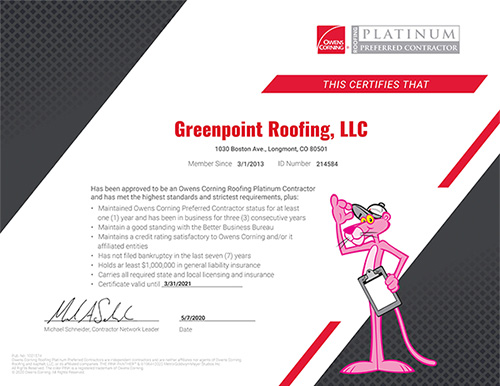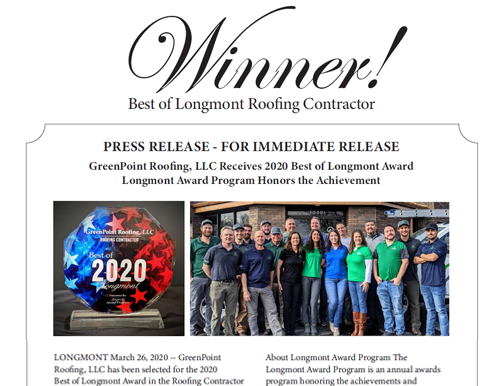5 (Undeniable) Signs that Your Roof Needs to be Replaced
As a general rule, you’ll get around 20-25 years before your roof needs to be replaced. Factors such as the climate you live in, as well as our Colorado hail, and the general upkeep regimen can also add or subtract years from this ballpark figure.
So, if you’re in the market to buy a house here in Longmont or the Denver metro area, it’s a good idea to request information on the age of the roof and the entire home. Once you know the approximate age of a roof, you can then estimate how many more years it should last.
And if you already own or rent a home with an older roof, watch for these signs that your roof needs to be replaced. Even if you have a relatively new structure, keep an eye out for issues after severe storms. You never know when a problem could come up.
Getting to know the following signs means that you can be aware of the condition of your roof and make an informed decision when it comes time to repair or replace it.
#1 It’s Just Not Working Anymore
A leaking roof is the most obvious sign that you need a complete replacement of your home roof. If you’re getting having mold issues, or find water spots or bubbles on ceilings and walls, your roof could certainly be the culprit.
For a younger roof, this is often the result of ignoring maintenance. And once a serious leak occurs, you will risk causing extensive damage to the point that your roof needs to be replaced. The best approach is to be vigilant and call in the professionals for regular inspections.
#2 Sagging & Dark Spots in the Attic
Regular visual inspections from the inside can give homeowners a good idea of the condition of their roof. From the inside of your attic, you can check for areas of sagging roof deck or water damage.
Examine the inside of the roof for mold growth, dark spots, or trails. This discoloration could be water damage, especially if it occurs near the seams and joints of the roof. You can also test your insulation for moisture.
Check during the day to see if sunlight enters through unsealed gaps in your roof. If sunlight can enter, that means rain, snow and cold air can also make its way into your home.
#3 Loose Granules & Exterior Issues
From the exterior of your home, you should regularly check your gutters for asphalt granules. Older shingles can start to lose their structural integrity, and one of the first signs of this is loose granules.
Without walking on the roof or putting yourself in a dangerous position, you should then visually inspect the shingles of your roof. If you notice a couple are missing, or that they are starting to curl upwards at the edges, this could indicate they are nearing the end of their functional lifespan.
Other key exterior issues to look out for include broken or damaged metal flashing, extensive mold coverage, drainage problems and a high percentage of cracked shingles.
If you notice any of the warning mentioned above signs, please don’t wait. Get in touch with a qualified and licensed roofing contractor right away. Our specialists here at GreenPoint Roofing can provide an inspection to determine if your roof needs to be replaced – or if it’s a candidate for repair. Call today!
Is There Such Thing as a Hail-Proof Roof?
At GreenPoint Roofing, one of the common types of roof damage we encounter is caused by hail. For homeowners across Colorado, hail is an inevitable reality.
Known as Hail Alley, the Front Range of Colorado and eastern plains of Wyoming experience the highest frequency of big hailstones in all of North America. They cause an astronomical level of damage to cars, homes, and property each year. In fact, it’s estimated that over the last decade, these storms have cost over $1.7 billion in damages.
Because you live in this high-risk zone, you may be wondering if there’s such thing as a hail-proof roof instead of just waiting for the day when your roof needs to be replaced. While we’d love there to be a product that could fend off devastating golf-ball, even softball-sized hail, there just isn’t a proven method yet.
The Closest Thing to a Hail-Proof Roof
While there are no guarantees, there are a number of factors that can help protect your roof. With the right materials and design, you can give your roof better protection and a fighting chance when the next storm rolls around.
The most important thing to avoid when reinforcing your roof against hail is to re-roofing over existing shingles. For best results, remove the old shingles and replace them with all new roofing materials. Here are a few more considerations.
Choosing the Correct Shingles
Generally, shingles made with polymer-modified asphalt will be more resistant than those made from conventional oxidized asphalt. A more precise way to measure the hail-resistance of shingles is to look at its rating from Underwriters Laboratories which designed a roofing materials test by dropping steel balls onto them and then classifying them according to their hail resistance on a scale of 1 to 4.
- A standard wooden shake will probably receive a Class-1 UL rating, due to its high susceptibility to damage from hailstones.
- Polymer-modified asphalt or concrete tiles are most likely to boast the highest rating of Class-4 UL due to their strength and resistance.
The Right Roof Design
Another factor that contributes significantly to hail-resistance is the pitch of your roof. Flatter roofs will suffer from a more forceful impact when hit by hailstones. Steeper roofs benefit from the inclined angle, as the hailstones are more likely to glance off the roof, saving it from having to absorb the full force of impact and finding out that your roof needs to be replaced. A roof pitch over 6:12 will offer better resistance to hail damage.
The Right Roof Decking
Additionally, for maximum protection, you should opt for rigid roof decking. Tongue and groove style decking or well-supported plywood sheathing will give the shingles extra support. Using a thin, single layer underlayment is another way to fortify a shingle roof. Modern materials are thinner, stronger and allow for better air permeation than traditional asphalt-saturated roofing felts.
If you have reason to install an entirely new roof or fully remodel the structure of your home, you can adjust your shingle type, roof pitch, decking and underlayment to create the optimum design for a more hail-proof roof. For existing structures, the most cost-efficient changes are updating the underlayment material and switching to high-quality shingles with a better UL rating.
While a hail-proof roof is not yet a reality, hail-resistant is within reach. For more information on making roof updates, please feel free to contact GreenPoint Roofing.















